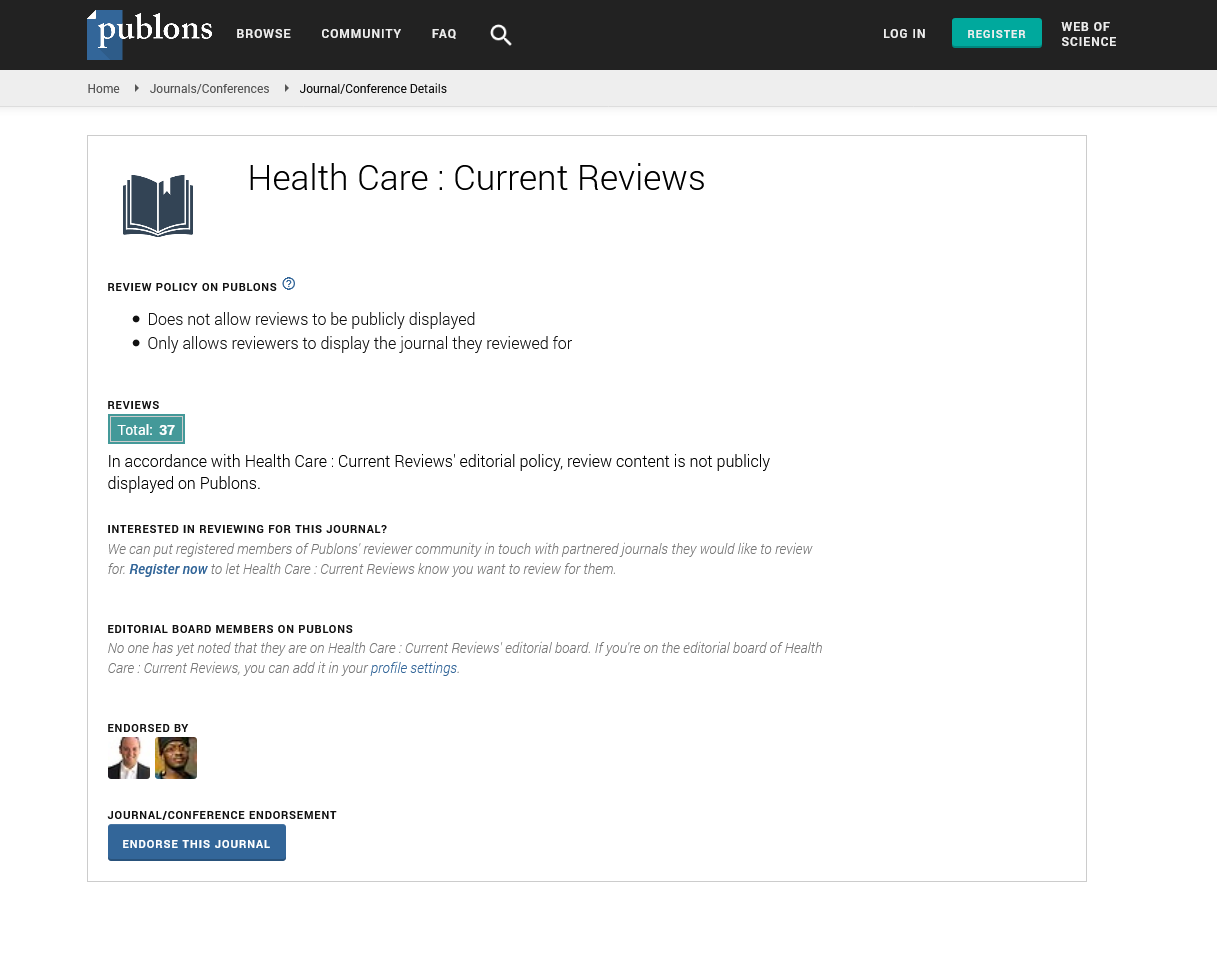Indexed In
- Open J Gate
- Academic Keys
- RefSeek
- Hamdard University
- EBSCO A-Z
- Publons
- Geneva Foundation for Medical Education and Research
- Google Scholar
Useful Links
Share This Page
Journal Flyer

Open Access Journals
- Agri and Aquaculture
- Biochemistry
- Bioinformatics & Systems Biology
- Business & Management
- Chemistry
- Clinical Sciences
- Engineering
- Food & Nutrition
- General Science
- Genetics & Molecular Biology
- Immunology & Microbiology
- Medical Sciences
- Neuroscience & Psychology
- Nursing & Health Care
- Pharmaceutical Sciences
Perspective - (2022) Volume 10, Issue 9
Health-Care Performance and its Evaluation in Health System
Grayson Harper*Received: 02-Sep-2022, Manuscript No. HCCR-22-18366; Editor assigned: 05-Sep-2022, Pre QC No. HCCR-22-18366(PQ); Reviewed: 19-Sep-2022, QC No. HCCR-22-18366; Revised: 26-Sep-2022, Manuscript No. HCCR-22-18366(R); Published: 03-Oct-2022, DOI: 10.35248/2375-4273.22.10.314
Description
Health system performance assessment at the district level has not received much attention in low- and middle-income nations. Some of the major issues are the lack of an extensive data gathering instrument and a uniform single summary measure defining overall success. A summary composite health system performance index at the district level is being developed as part of the current study. The healthy growth of people, families and societies which along with a number of other elements, affect the lives of a great number of people, is largely dependent on health systems. They are in charge of enhancing population health in a high-quality and low-cost per capita manner. The World Health Organization (WHO) specified six components of the health system in its framework for Action based on the expected functions. Understanding progress, overcoming obstacles and suggesting solutions all depend on measuring the functioning of the health system. This aids in developing systems that are effective, equitable, patient-centered, accessible and sustainable in addition to producing results in terms of improved service coverage. Additionally, understanding the links between the performance of the components of the health system and the outcome indicators facilitates the alignment of performance with the specific goals sought by companies and systems.
In addition to evaluating structure, method and outcomes this evaluation should also evaluate the effectiveness and equality of the healthcare delivery system in order to provide a holistic assessment of healthcare quality. Over the past few decades, laudable efforts have been undertaken in high income nations to design and apply performance assessment frameworks and procedures. There are both particular frameworks created by nations taking into account the unique characteristics of their national health systems and general frameworks created by the WHO. Frameworks examining particular healthcare system pillars, such as governance and associated performance assessment methods have also been created and compared for use at the regional level. However, only a small amount of work has been done in this approach in Low and Middle Income Nations (LMIC). Since 2001, the Ministry of Health has published an annual health system performance report that uses league table analysis to provide data on local government performance, health service coverage levels, and health sector performance. Thus, the most instances of the use of health system performance frameworks for assessments in LMIC have been at the national level or occasionally at sub-national or regional levels. However, it is equally crucial to comprehend how the health system is performing at the state or district levels because, in the majority of nations with a federal structure, these are the places where policies and programmers are put into action. With more emphasis on decentralizing administrative and financial capabilities for local level planning and execution in the majority of LMICs, this district level assessment becomes even more pertinent. For instance, the National Rural Health Mission (NRHM) in India, which was established in 2005 to increase the accessibility and availability of high-quality healthcare, placed a significant emphasis on district management of health programmers and decentralization for better governance. However, there are a number of methodological issues with district-level performance measurement. Another issue is the lack of a single data gathering technology that can provide thorough data on all components of the health system. The majority of the currently available tools focus on assessing healthcare facilities, gathering data on resource management and to a lesser extent service delivery at healthcare facilities, skipping other building blocks like governance, health information systems, and local financial management.
A uniform summary measure that can combine all the factors used to determine the performance of the health system into a single number is also needed in order to give policymakers the information they need to make decisions. A single index summary measure may be useful in presenting an overall comparison among different regions, even though disaggregated findings created by individual assessment of all building blocks and their sub-components are essential to highlight the relevant areas of concern and implement corrective measures. By lowering the perceived size of a set of indicators without losing the underlying information base, such a metric can summarize complicated, multidimensional reality. In this regard, the current study was designed as a component of doctorate research with the goal of creating a summary composite index for evaluating the overall performance of the health system at the district level.
Citation: Harper G (2022) Health-Care Performance and its Evaluation in Health System. Health Care Curr Rev. 10:314.
Copyright: © 2022 Harper G. This is an open-access article distributed under the terms of the Creative Commons Attribution License, which permits unrestricted use, distribution, and reproduction in any medium, provided the original author and source are credited.

